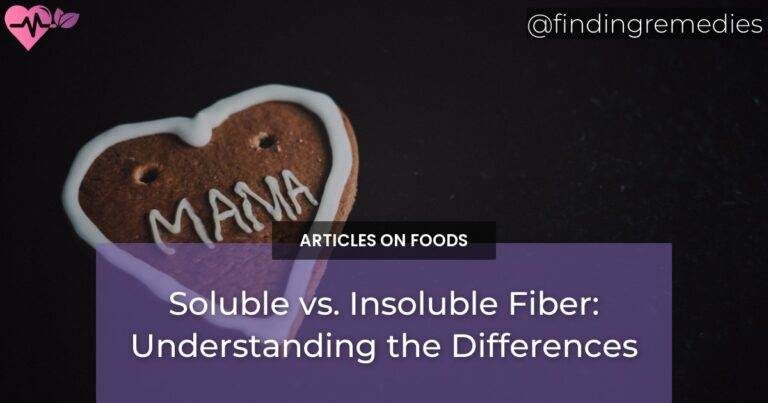When it comes to maintaining a healthy diet, one important factor that often gets overlooked is fiber. Not only does it aid in digestion and keep our digestive system running smoothly, but it also has numerous other health benefits. However, not all fiber is created equal. There are two main types of fiber: soluble and insoluble. Understanding the differences between these two types of fiber can help you make informed choices about your diet and improve your overall health.
In this article, we will delve into the world of soluble vs insoluble fiber, their benefits, and the best sources to incorporate into your diet.
Table of Contents
Introduction
What is Fiber?
Fiber is a type of carbohydrate that is essential for our bodies. Unlike other carbohydrates, fiber cannot be digested by our bodies, meaning it passes through our digestive system intact. This makes it an essential component of a healthy diet as it helps to regulate digestion and keep our digestive tract functioning efficiently.
Types of Fiber
There are two main types of fiber: soluble and insoluble. Soluble fiber dissolves in water and forms a gel-like substance in our digestive tract, while insoluble fiber does not dissolve in water and passes through our digestive system without being broken down. Both types of fiber are crucial for maintaining good overall health and should be incorporated into our diets in the right proportions.
ALSO READ
Importance of Fiber in a Healthy Diet
Fiber plays a vital role in maintaining a healthy diet. It helps to regulate digestion, prevent constipation, and keep our digestive system functioning efficiently. Additionally, fiber can also aid in weight management, lower cholesterol levels, and improve blood sugar control. It is recommended that adults consume between 25-30 grams of fiber per day, but unfortunately, many of us fall short of this target.
Soluble Fiber
Definition of Soluble Fiber
Soluble fiber is a type of fiber that dissolves in water and forms a gel-like substance in our digestive tract. This gel-like substance helps to slow down digestion, which can be beneficial for certain health conditions such as diabetes and high cholesterol.
ALSO READ
Benefits of Soluble Fiber
Soluble fiber has numerous health benefits. It helps to slow down digestion, which can help manage blood sugar levels and lower cholesterol levels. Additionally, it also promotes the growth of beneficial bacteria in our gut, which can help improve overall digestive health.
Foods High in Soluble Fiber
There are many foods that are high in soluble fiber, including:
- Oats
- Beans and legumes
- Fruits and vegetables
- Nuts and seeds
Incorporating these foods into your diet can help you increase your intake of soluble fiber and reap its health benefits.
Insoluble Fiber
Definition of Insoluble Fiber
Insoluble fiber is a type of fiber that does not dissolve in water and passes through our digestive system without being broken down. It helps to add bulk to our stool and promote regular bowel movements.
Benefits of Insoluble Fiber
Insoluble fiber has many benefits, including promoting regular bowel movements and preventing constipation. It can also help to keep our digestive system healthy and prevent certain health conditions such as diverticulitis.
Foods High in Insoluble Fiber
Some foods that are high in insoluble fiber include:
- Whole grains
- Bran
- Vegetables
- Fruit skins
Adding these foods to your diet can help you increase your intake of insoluble fiber and improve your digestive health.
Soluble vs. Insoluble Fiber: Key Differences
Digestion
One of the main differences between soluble and insoluble fiber is how they are digested by our bodies. Soluble fiber dissolves in water and forms a gel-like substance, while insoluble fiber does not dissolve and passes through our digestive system unchanged.
Effect on Blood Sugar
Soluble fiber can help to slow down digestion, which can be beneficial for managing blood sugar levels. On the other hand, insoluble fiber does not have a significant impact on blood sugar levels.
Impact on Cholesterol Levels
Soluble fiber can help to lower cholesterol levels by binding to cholesterol and preventing it from being absorbed into our bodies. Insoluble fiber does not have the same impact on cholesterol levels.
Role in Weight Management
Both types of fiber can aid in weight management by promoting feelings of fullness and slowing down digestion, but soluble fiber may have a slight edge in this area due to its impact on blood sugar levels.
How Do Soluble and Insoluble Fiber Affect Your Micronutrient Intake?
Soluble fiber can slow down digestion, impacting the absorption of micronutrients like vitamins and minerals. Insoluble fiber, on the other hand, can help promote better digestion and nutrient absorption. When tracking your micros nutrients intake, consider the impact of different types of fiber on your overall nutrient absorption.
Conclusion
Incorporating both soluble and insoluble fiber into our diets is essential for maintaining good overall health. Soluble fiber can help to manage blood sugar and cholesterol levels, while insoluble fiber promotes regular bowel movements and digestive health. By understanding the differences between these two types of fiber and incorporating them into our diets in the right proportions, we can reap the many benefits of fiber and improve our overall well-being.
RELATED ARTICLES:

